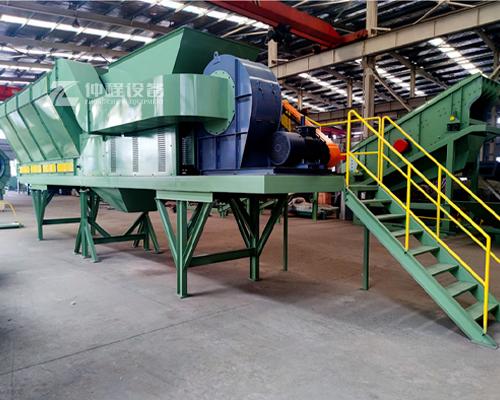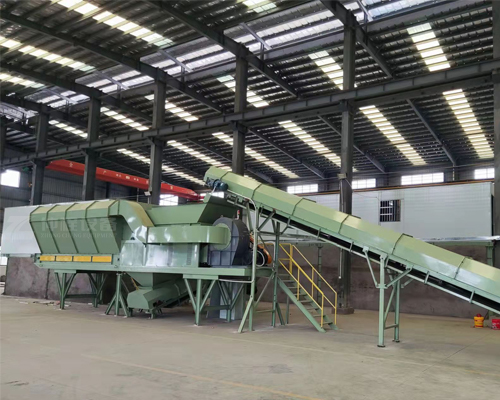About the air separator
Air Separators in Waste Sorting Equipment
In the realm of waste management and recycling, the efficiency and effectiveness of sorting technologies play a crucial role in the sustainability of our environment. Among the various equipment used for sorting and separating materials, air separators stand out as an innovative and efficient solution. These machines leverage the power of airflow to separate different types of materials based on their density and aerodynamic properties, making them indispensable in the processing of mixed waste streams.

How Air Separators Work
An air separator operates by creating a controlled stream of air that passes through a mixture of materials. As the materials move through this airstream, lighter materials are carried away by the air while heavier materials fall to the bottom. The principle behind this is simple yet effective: different materials have different densities and aerodynamic characteristics, which allow them to be separated using air currents.
The process typically involves the following steps:
1. Feeding: Mixed waste is fed into the air separator.
2. Airflow Generation: Powerful fans generate a strong airstream.
3. Separation: Materials are lifted or pushed by the air depending on their weight and shape.
4. Collection: Lighter materials are collected at one end, while heavier materials are collected at the other.
Applications of Air Separators
Air separators find applications across a wide range of industries, including but not limited to:
- Recycling Facilities: They are used to separate paper from plastics, metals, and other contaminants in municipal solid waste (MSW) streams.
- Construction and Demolition Waste: Air separators help in separating lightweight debris like wood chips and insulation from heavier materials such as concrete and bricks.
- Agricultural Processing: In the processing of agricultural products, air separators can be used to remove chaff and other light debris from grains.
- Manufacturing Industries: They assist in the separation of packaging materials, such as cardboard and plastic films, from production lines.

Advantages of Using Air Separators
The use of air separators offers several advantages over traditional mechanical sorting methods:
- High Efficiency: Air separators can achieve high throughput rates, making them suitable for large-scale operations.
- Cost-Effective: They require less maintenance compared to other sorting technologies and can reduce labor costs.
- Versatility: Air separators can handle a variety of material types and sizes, making them adaptable to different sorting needs.
- Environmental Benefits: By improving the efficiency of recycling processes, air separators contribute to reducing landfill usage and conserving natural resources.
Challenges and Considerations
Despite their benefits, air separators also come with certain challenges:
- Dust Control: The operation of air separators can generate significant amounts of dust, which may require additional dust collection systems.
- Energy Consumption: Generating powerful airstreams requires substantial energy, which can impact operational costs and environmental footprints.
- Material Specificity: Some materials, especially those with similar densities, may be difficult to separate effectively using air alone.
Future Trends
As technology advances, air separators are becoming more sophisticated. Innovations in design and control systems are enhancing their performance, making them even more efficient and versatile. For example, the integration of sensors and artificial intelligence can optimize the separation process by adjusting airflow parameters in real-time based on the material composition.
| Wind Sifter800 | Wind Sifter1200 | Wind Sifter1600 | |
| Feeding Belt Width | 800mm | 1200mm | 1600mm |
| Air volume | 8000-19000 m³/h | 12000-29000 m³/h | 15000-35000 m³/h |
| Full pressure | 2500Pa | 2500Pa | 2500Pa |
| Power | 38kw | 42kw | 55kw |
| Throughput | 20-30 m³/h | 30-50 m³/h | 50-70 m³/h |
air separators are a vital component of modern waste sorting and recycling systems. Their ability to efficiently and effectively separate materials based on density and aerodynamic properties makes them a sustainable solution for enhancing material recovery and reducing waste. As the world continues to focus on environmental sustainability, the role of air separators in waste management is likely to grow, contributing to a cleaner and more resource-efficient future.
-
 Trommel screenTrommel screen, also known as drum screens, are widely used in various industries for sorting and separating materials.Get Quote
Trommel screenTrommel screen, also known as drum screens, are widely used in various industries for sorting and separating materials.Get Quote -
 Crop straw double shaft shreddApplications:Biomass Energy Production: Shredded straw can be used as a feedstock for bioenergy plants to produce electricity or heat.Livestock Feed: Reduced-si...Get Quote
Crop straw double shaft shreddApplications:Biomass Energy Production: Shredded straw can be used as a feedstock for bioenergy plants to produce electricity or heat.Livestock Feed: Reduced-si...Get Quote -
 Zhongcheng Air Drum SeparatorAir drum separators effectively separate lightweight materials (e.g., plastics, paper) from heavier materials (e.g., metals, glass). This high efficiency is cru...Get Quote
Zhongcheng Air Drum SeparatorAir drum separators effectively separate lightweight materials (e.g., plastics, paper) from heavier materials (e.g., metals, glass). This high efficiency is cru...Get Quote
-
2024-04-13Wobbler FeederWobbler feeder is a type of feeding equipment that uses rotating elliptical bars, known as wobblers, to separate materials based on size and type before they re...
-
2024-05-29Landfill stale garbage screening projectAfter communicating with our domestic customers in Shandong Province, we learned that he needed to dispose of the garbage in the landfill through excavation, sc...
-
2023-01-11Trommel screenTrommel screen, also known as drum screens, are widely used in various industries for sorting and separating materials.
-
2024-08-05Hot-sell Coconut Shredderworking principleCoconut shell shredder usually uses the force generated by cone and spiral to evenly squeeze the coconut meat in the grinding chamber between t...
-
2025-03-03Mini Copper Wire GranulatorThe copper wire granulator machine is a device specially used to process waste wires and cables. Its main function is to separate the copper and plastic in the ...



